|
After 16 hours of travel, on four different flights with three different airlines we arrived in Cuzco, Peru. When I mentioned to people that we were visiting Peru, many people assumed I had read The Celestine Prophecy, I never even heard of it, still haven't read it. High in the Andean mountains you are not sure at first whether your shortness of breathe is due to the thinnest of the air or the stunning beauty of the city. In my humble opinion Cuzco is the most beautiful city in Peru and one of the most beautiful city I have visited in the world, only Rio de Janerio, Brazil and maybe Granada, Spain is more beautiful. My wife thinks Arequipa is Peru's most beautiful city. |
|
|
|
|
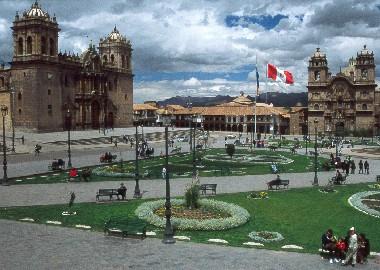
At over 3300 metres above sea level, it can take several days for the body to adjust to the thinnest of the air. Don't worry, there is plenty to see and do in Cuzco.
Several warnings about the thin air. For the first couple of days don't push your body too much. I know that can be hard to do when you are visiting somewhere new but slow your pace. Also avoid alcohol and caffeine for the first couple of days. Many people recommend either drinking coca tea or chewing coca leaves. Yes, this is the very same coca leaves that cocaine is made from but its legal in Peru, coca leaves that is, not cocaine. You will get a mild buzz, especially if you chew the leaves. It is often a problem for drug officials since coca is a native wild plant used by the Incas, to distinguish between legal coca fields and the illegal.
As the oldest continuous inhabited city in the Americans Cuzco is a city rich in history, culture and archeology. The Spanish build the city on top of the Inca foundations and whenever there is an earthquake cracks will appear in many of the buildings but the Inca foundations remain solid.
The first thing you should get when you arrive in Cuzco is get a Cusco Visitor Ticket. At a cost of US$10 this is good value if you plan on visiting many sites in and around Cuzco. Many of the tours are priced to the local middle class so for the average North American or European that means cheap local tours. A 1/2 day tour of Cuzco and the surrounding area will cost about 12 sols (about US$4). The tour will include visits in many of the larger and more interesting churches and four of the Inca ruins just outside the city. There are often many locals on these tours so make sure you have a bilingual guide if you don't understand Spanish.
The main Cathedral, building started in 1559, fronts on the main square, Plaza de Armas, and contains many interesting paintings from the Cuzco school of painting, a combination of 16th century European style and Inca imagination. My favorite was the Last Supper which depicts a supper consisting of the Inca delicacy cuy, or roast guinea pig. Another interesting church is Santo Domingo which is build on top of the Inca temple Coricancha.
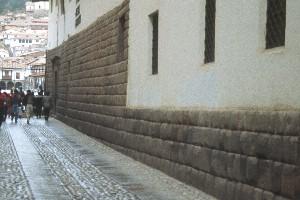 In the earthquakes of 1650 and 1950 the church was destroyed and it was heavily damaged in the 1986 earthquake but the Inca foundation remained intact. Admission to this church is not included with the Cuzco Visitor Ticket but the inside of the church has several small Inca structures and is worth the cost of a few sols.
In the earthquakes of 1650 and 1950 the church was destroyed and it was heavily damaged in the 1986 earthquake but the Inca foundation remained intact. Admission to this church is not included with the Cuzco Visitor Ticket but the inside of the church has several small Inca structures and is worth the cost of a few sols.
Several Inca walls still exist around Cuzco. The best, along with Coricancha, is the alley of Loreto in the southeast corner of Plaza de Armas. The Hotel Loreto has a few rooms that have Inca walls.
As one of the most visited cities in Peru there are plenty of hotels in all price ranges but it is the second most expensive place in Peru (after Lima). If you are looking for cheap eating there are several places near the Plaza de Armas. An alley leaving the Plaza on the northwest side called Procuradores - but with the nickname Gringo Alley - has become a haven for budget travellers. If vegetarian is your thing try Govinda's on Espaderos - its very cheap but service can be slow. If your
adventurous try the Inca delicacy cuy - or roast guinea pig - but don't believe people when they tell you it tastes like chicken, it tastes more like rabbit. My only complaint is that there is not enough meat on one guinea pig and being a delicacy its a bit expensive.
The areas near Plaza de Blas has several artisan markets. Bargaining is expected. The prices are very good and you probably will not get much lower prices in smaller communities. There are several cybercafes around the plazas which cost about 2 sols per half hour.
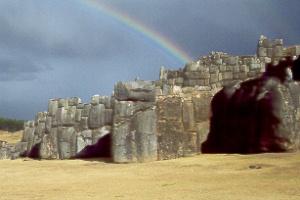
A city tour will also take you to four Inca ruins near Cuzco, the admission price is included with your visitor ticket. The first one you will visit is the ruins of Sacsayhuaman (remember the name using the mnemonic 'sexy woman') a huge fortification of which only about 20% remains. The Spanish used the rest to build their own houses. The site had important religious and military significance and was the site of one of the most bitter battles of the Spanish conquest. Some of the blocks weigh over 300 tonnes. 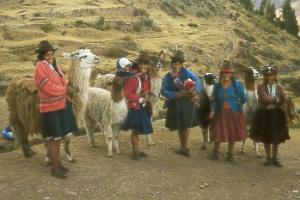 You will find many locals dressed in traditional clothes with their llamas, hoping to be photographed. They consider themselves professional models and expected to be paid. A sol will be enough.
You will find many locals dressed in traditional clothes with their llamas, hoping to be photographed. They consider themselves professional models and expected to be paid. A sol will be enough.
The other three sites are smaller; Qenko consists of a large limestone rock covered with carvings, Puca Pucara is a small fort while Tambo Machay appears to be a ceremonial stone bath.
At 3700 metres Tambo Machay is the highest point along this route. If your on a really tight budget, some travellers get the local Pisca bus and get off at Tambo Machay and visit all the sites as they walk back to Cuzco, its about 8 km. Puca Pucara looks remarkable like an European fort which just indicates that form follows function.
Return to Top
The beautiful Urubamba River valley is popularly called El Valle Sagrado, or the Sacred Valley of the Incas. Its about 15 km from Cuzco with a more pleasant climate since its 600 metres lower, Cuzco can get chilly at night. 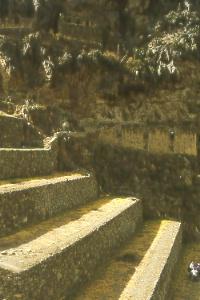 A day long tour will cost about 25 sols but does not include lunch. A tour will visit several local markets and Inca ruins, make sure where the tour visits before you pay. Our tour only visited the market in Pisac so we just hiked up to the ruins. The Pisac market is only really busy on Sunday and is not any cheaper than the markets in Cuzco.
A day long tour will cost about 25 sols but does not include lunch. A tour will visit several local markets and Inca ruins, make sure where the tour visits before you pay. Our tour only visited the market in Pisac so we just hiked up to the ruins. The Pisac market is only really busy on Sunday and is not any cheaper than the markets in Cuzco.
The other major Inca site visited on most tours is Ollantaytambo, a massive fortress and the site of one of the few losses by the Spanish during their conquest. This is also an unfinished city at the time of the Spanish conquest and walls that were under construction can be seen. The stone used to built this city was quarried from a mountainside about 6 km away on the other side of the Rio Urubamba. These ruins are certainly an indication of Inca
engineering.
Our tour also visited Chinchero which combines an Andean village, Inca ruins, a colonial church and a market. Until recently this village was under the control of the Shining Path and tour groups did not stop, it is still rarely visited. The church is build on top of Inca foundations but is in a bad state of repair. The freshly steamed corn at the market was good.
Return to Top
From southern Columbia to northern Chile there is over 5000 kilometres of Inca road but to most people the Inca Trail is the road to Machu Picchu. The Inca trail can take 3 to 5 days to hike and plenty of agencies in Cuzco offer package tours that include guide, porters, food, tents etc. I've meant several people who hiked the trail themselves so it can be done. Normally hiking the Inca Trail involves getting the Machu Picchu train from Cuzco to Kilometre 88. Most guide books will tell you only the local train stops at kilometre 88, while cheap pickpockets are known to target gringos on this train. Recently the tourist trains also stop at kilometre 88. Security is better and because of the cost not many locals use this train. You can store any excess luggage at your Cuzco hotel, most offer luggage storage at no extra cost.
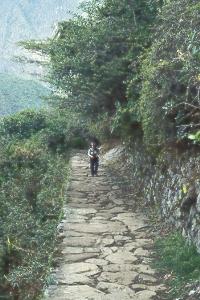
If time is short or the idea of hiking and camping for several days is not your idea of fun there is now a shorter Inca Trail. Starting at kilometre 104 it only takes a day to hike. Since not many people use this trail let the conductor know you want to be let off. Most agencies offer this trail as a two day hike but unless you are very unfit or very slow the trail can easily be done in about 4-5 hours.
After you cross the river you pay your Inca Trail and Machu Picchu fee which is US$12. This is the only place in Peru which charges higher fees for
foreigners, although this is suppose to change in the future. There are some small ruins just after the bridge called Chachabamba but more impressive ruins await you. The first part of the hike is fairly steep and crosses a mountain meadow but gives good views of the valley floor. After passing a waterfall and climbing up some Inca staircase you arrive at the ruins of Huiñay Huayna after about 2.5 - 3 hours.
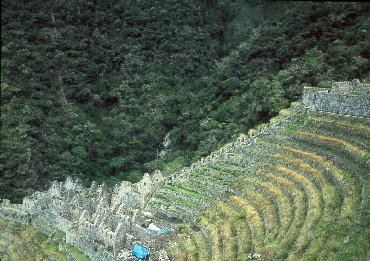
You will see Huiñay Huayna as you hike along the meadow part of the trail, built right into the side of the mountain. Except for a couple of
archeologists we had the site to ourselves. This is a small but impressive ruin with running water and stone baths and curved
agricultural terracing.
About 5 minutes pass Huiñay Huayna is a small hostel but you will probably smell stale urine before you site the hostel. This hostel is often used as the last overnight stop on the Inca Trail and we'll see plenty of tents in the area. Food and drink is available but the smell of urine will make you question the
hygiene.
Immediately after the hostel is the recently discovered terraced ruin of Conchamarca which can be visited. About 1.5- 2 hours after the hostel you will
arrive at Intipunku, or 'gateway to the sun,' and get your first view of Machu Picchu and the view is worth the hike. It then takes about a half hour to reach the site.
Return to Top
The main reason many people visit Peru is to see the wonder of Machu Picchu, a city unknown to the Spanish and only rediscovered in 1911.
If you have money to burn there are helicopter flights from Cuzco or you can visit the site by taking the train from Cuzco to Aquas Calientes then a bus to the site. During the peak of the summer tourist season over a thousand people visit per day. Its especially crowded from about 10:30 after the train arrives to about 2:30 as people catch the returning train to Cuzco. The
adventurous take one of the Inca trails.
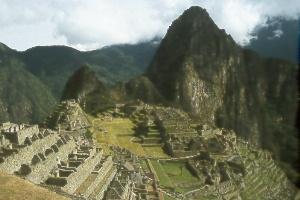
Taking the shorter Inca trail we arrived at Machu Picchu about 2:30 when most people were leaving so there were few people at the site. We stayed in Aquas Calientes overnight and visited the site early in the morning then hiked some trials during the busy time before catching the train back to Cuzco.
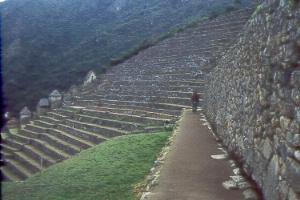
Aquas Calientes is located about 700 metres below Machu Picchu at the end of twisting 6 km road. A pleasant town with hot springs, a great way to relax after a hike. There is basically two paths in town, one along the railroad track and another on the path to the hot springs. You will find a range of
accommodations and eating establishments. There is one hotel just outside the ruins, most people seem to think it has Ritz-Carlton prices with Motel 6 services.
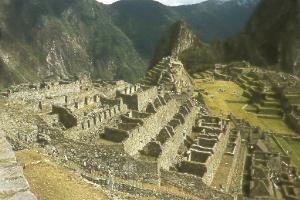
Up bright and early the next morning to catch the first bus to the site and spend a few hours at the site before the train arrived from Cuzco. Although you are not allowed to bring food into the site, the prices at the on-site cafeteria are outrageous. Your daypack will not be searched and please take your garbage out. Even though many guide books tell you that you have to purchase a new entrance ticket the next day your Inca Trail ticket should be valid for several days so don't throw it away.
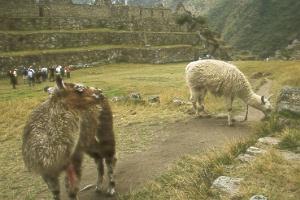
After spending several hours at the ruins and shooting an entire roll of film, we hiked some trails near the site. This is one of the few places where shooting a entire roll of film does not seem a waste, in fact you might wish you had more film. The Grand Canyon (Arizona, U.S.A.), Alhambra (Granada, Spain), Chichén Itzà (Yucatan, Mexico) and Ngorongoro Crater (Tanzania) were other places I visited that I wish I took more pictures.
There are several hikes at Machu Picchu, the main one being hiking up the mountain, Huayna Picchu, behind the site. Its a steep ascent but a well maintained trail, my wife quit half way up. Its about a two hour round trip. Another shorter and easier hike is to the Inca drawbridge. It takes about half hour round trip as the trail hugs the cliff. A barrier blocks access to the drawbridge itself, in the past people have fell to their deaths. If you did not hike the Inca Trail you can hike to Intipunku, probably about an hour round trip.
After an afternoon and most of one day at Machu Picchu we were ready to return to Cuzco. We had purchased round trip tickets in Cuzco but I could not find my return ticket. I did not lose it, I don't lose things, I'm actually a bit of a pack rat. I just misplaced the ticket, I found the ticket several days later stuck in my passport. There was plenty of seats in second class, so I
traveled by myself in second class while my wife sat in the first class.
Return to Top
It was late when we arrived in Cuzco and we had an early morning flight into the jungle the following day.
 In the earthquakes of 1650 and 1950 the church was destroyed and it was heavily damaged in the 1986 earthquake but the Inca foundation remained intact. Admission to this church is not included with the Cuzco Visitor Ticket but the inside of the church has several small Inca structures and is worth the cost of a few sols.
In the earthquakes of 1650 and 1950 the church was destroyed and it was heavily damaged in the 1986 earthquake but the Inca foundation remained intact. Admission to this church is not included with the Cuzco Visitor Ticket but the inside of the church has several small Inca structures and is worth the cost of a few sols.

 You will find many locals dressed in traditional clothes with their llamas, hoping to be photographed. They consider themselves professional models and expected to be paid. A sol will be enough.
You will find many locals dressed in traditional clothes with their llamas, hoping to be photographed. They consider themselves professional models and expected to be paid. A sol will be enough. A day long tour will cost about 25 sols but does not include lunch. A tour will visit several local markets and Inca ruins, make sure where the tour visits before you pay. Our tour only visited the market in Pisac so we just hiked up to the ruins. The Pisac market is only really busy on Sunday and is not any cheaper than the markets in Cuzco.
A day long tour will cost about 25 sols but does not include lunch. A tour will visit several local markets and Inca ruins, make sure where the tour visits before you pay. Our tour only visited the market in Pisac so we just hiked up to the ruins. The Pisac market is only really busy on Sunday and is not any cheaper than the markets in Cuzco.




